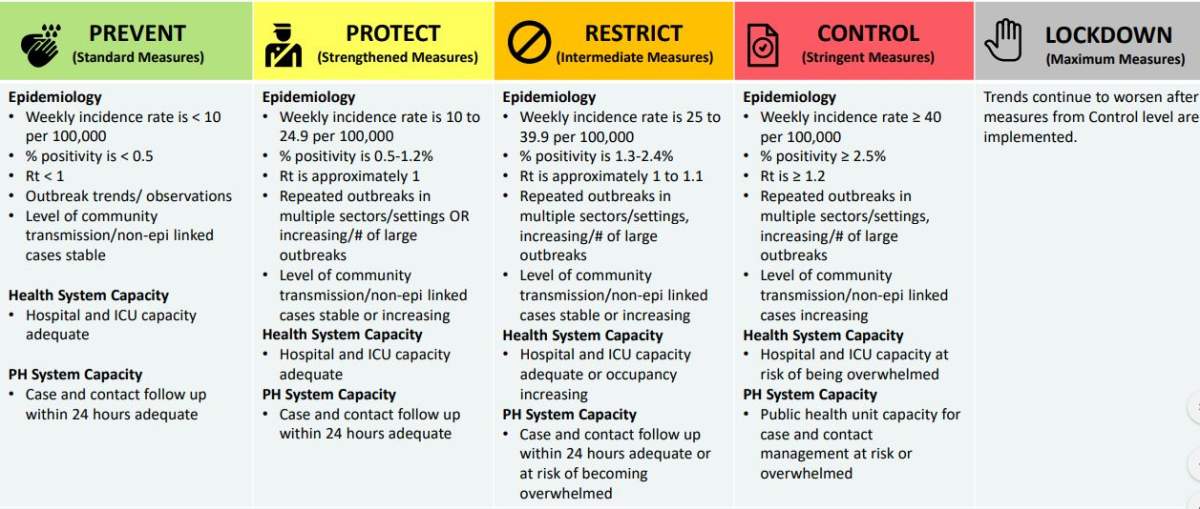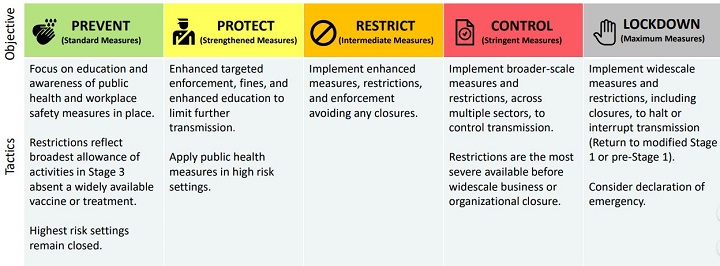The Ontario government announced it will be lowering the threshold on its new colour-coded COVID-19 restrictions system as coronavirus cases surge, bringing Hamilton as well as the regions of Halton and York into the red zone with Toronto and Peel Region.

Ontario Premier Doug Ford made the announcement alongside Health Minister Christine Elliott and the province’s chief medical officer of health Dr. David Williams during a news conference at Queen’s Park on Friday.
“Everyone has a role to play … we need to continue to fight … please don’t lose hope,” Ford said. “Never has so much depended on us coming together as a people, a province. Together we can and we will get through this.”
Elliott said the following public health regions would move to the orange level: Durham, Brant, Eastern, Niagara, Ottawa, Waterloo, Wellington-Dufferin, and Guelph.
Haldimand, Huron Perth, Middlesex-London, Simcoe, Southwestern, Windsor-Essex will move to the yellow level.
All units will move to the new levels at 12:01 a.m. on Monday, however, Toronto moves to the red level as of 12:01 a.m. Saturday. Elliott said all those living in a red zone should only leave home for essentials.
But Ford warned the most recent modelling shows the province is “staring down the barrel of another lockdown” and said he will not hesitate to make further changes if needed.
The province’s top public health doctor has been asked to provide advice next week on whether more measures are needed, Ford said.
Last week, Ontario originally released the new colour-coded system that classifies regions depending on the presence of the virus.
The framework was met with increased criticism, with municipal public health units adding more strict restrictions on regions with high numbers, including Toronto, which announced the extension of the closures of indoor fitness classes and indoor dining for another 28 days before Friday’s announcement.
The province released new modelling numbers Thursday which warned Ontario could hit 2,500 cases per day at a three-per-cent growth rate and around 6,500 a day at a five-per-cent growth rate by mid-December, according to government documents.

Get weekly health news
Health officials said that right now, five per cent growth is an “optimistic scenario.” Elliott said the province is now at a 4.4 per cent growth rate with cases.
Under the modified system, a region will be categorized as a red zone if it records a weekly incidence rate of 40 or more per 100,000 people, and a per cent positivity rate of 2.5 or more. Previously, the threshold for that level was a weekly incidence rate of 100 or more per 100,000 people and a per cent positivity rate of 10 or higher.
When asked why he waited so long to lower the threshold, Ford said the modelling numbers he saw ten days ago were much lower (950-1,200 cases a day). He said he wouldn’t have approved those thresholds if Thursday’s numbers were the ones that he saw.
Friday’s announcement did little to reassure some critics, who said the changes are too little, too late.
The Registered Nurses’ Association of Ontario, which has called for a 28-day lockdown of everything but schools and essential services in red zones, said the province has been too slow to take decisive action.
“The longer we wait, the bigger the danger that we’ll end up with a provincewide lockdown. The situation is quite close to being uncontrollable. We’re waiting too long,” Doris Greenspun, the association’s CEO, said following the announcement.
Ontario reported 1,396 new cases of coronavirus on Friday: 440 new cases were recorded in Toronto, 440 in Peel Region, 155 in York Region and 55 in Halton Region.
All other public health units in Ontario reported under 50 new cases.
There are 452 people in hospital due to COVID-19, 106 in intensive care, and 67 on ventilators.
As of Friday, Ontario has reported a total of 91,180 coronavirus cases and 3,312 deaths since the pandemic began in March.
—With files from The Canadian Press

















Comments